
A constellation is an area on the celestial sphere in which a group of visible stars forms a perceived pattern or outline, typically representing an animal, mythological subject, or inanimate object.

In Greek mythology, Callisto was a nymph, or the daughter of King Lycaon; the myth varies in such details. She was believed to be one of the followers of Artemis who attracted Zeus. Many versions of Callisto's story survive. According to some writers, Zeus transformed himself into the figure of Artemis to pursue Callisto, and she slept with him believing Zeus to be Artemis. She became pregnant and when this was eventually discovered, she was expelled from Artemis's group, after which a furious Hera, the wife of Zeus, transformed her into a bear, although in some versions Artemis is the one to give her an ursine form. Later, just as she was about to be killed by her son when he was hunting, she was set among the stars as Ursa Major by Zeus. She was the bear-mother of the Arcadians, through her son Arcas by Zeus.

In Greek mythology, Amalthea or Amaltheia is the most-frequently mentioned foster-mother of Zeus.
In Greek mythology, multiple characters were known as Cycnus or Cygnus. The literal meaning of the name is "swan", and accordingly most of them ended up being transformed into swans.
Gaius Julius Hyginus was a Latin author, a pupil of the scholar Alexander Polyhistor, and a freedman of Caesar Augustus. He was elected superintendent of the Palatine library by Augustus according to Suetonius' De Grammaticis, 20. It is not clear whether Hyginus was a native of the Iberian Peninsula or of Alexandria.
Hyas, in Greek mythology, was a Boeotian who was regarded as the ancestor of the ancient Hyantes (Ὕαντες), who were the aboriginal inhabitants of Boeotia. His name means rain from hyô, hyetos.
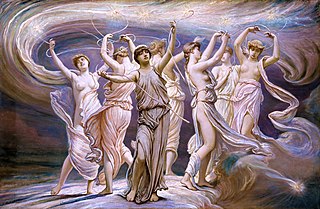
The Pleiades, were the seven sister-nymphs, companions of Artemis, the goddess of the hunt. Together with their sisters, the Hyades, they were called the Atlantides, Dodonides, or Nysiades, nursemaids and teachers of the infant Dionysus. The Pleiades were thought to have been translated to the night sky as a cluster of stars, the Pleiades, and were associated with rain.
In Greek mythology, the Hyades are a sisterhood of nymphs that bring rain.
The Catasterismi or Catasterisms is a lost work attributed to Eratosthenes of Cyrene. It was a comprehensive compendium of astral mythology including origin myths of the stars and constellations. Only a summary of the original work survives, called the Epitome Catasterismorum, by an unknown author sometimes referred to as pseudo-Eratosthenes.
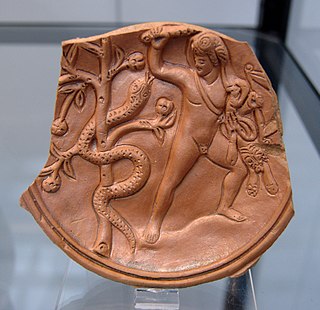
Ladon was a monster in Greek mythology, the dragon that guarded the golden apples in the Garden of the Hesperides.
In Greek mythology, Hippe, also known as Melanippe or Euippe, was the daughter of the Centaur Chiron and Chariclo. She was seduced by Aeolus and bore a daughter, Melanippe or Arne, but was ashamed to tell her father. Artemis took pity on her and, according to one account, turned her into the constellation Pegasus originally called the Horse.
In Greek mythology, Aega or Pine or Cynosura or Melissa was, according to Hyginus, a daughter of Olenus, who was a descendant of Hephaestus. Aega and her sister Helice nursed the infant Zeus in Crete, and the former was afterwards changed by the god into the constellation called Capella.

Aegipan was a mythological being, either distinct from or identical to Pan. His story appears to be of late origin.
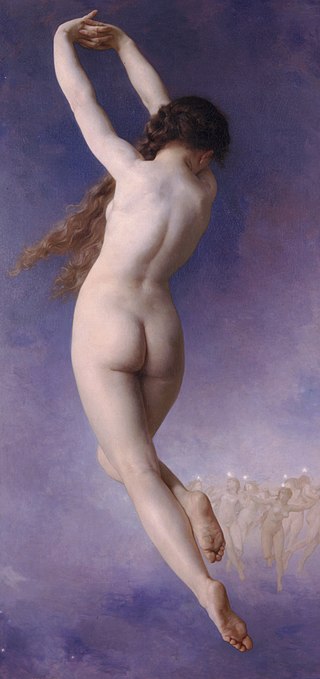
In Greek mythology, Merope is one of the seven Pleiades, daughters of Atlas and Pleione. Pleione, their mother, is the daughter of Oceanus and Tethys and is the protector of sailors. Their transformation into the star cluster known as the Pleiades is the subject of various myths.
In Greek mythology, Paeon or Paion was a son of Poseidon by Helle, who fell into the Hellespont. In some legends he was called Edonus. He was the brother of the giant Almops.
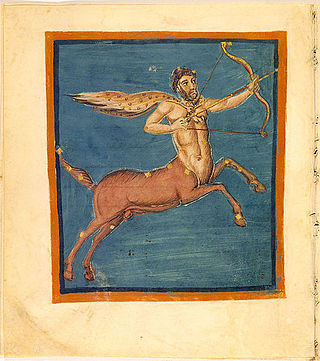
In Greek mythology, Krotos or Crotus was the son of Pan and Eupheme. He dwelt on Mount Helicon and kept company of the Muses, whom his mother had nursed.
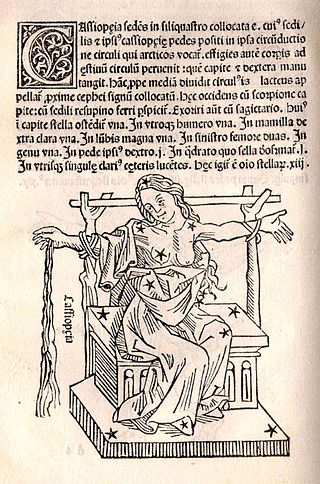
Cassiopeia or Cassiepeia, a figure in Greek mythology, was Queen of Aethiopia and wife of King Cepheus. She was arrogant and vain, characteristics that led to her downfall.
In Greek mythology, Cynosura is the name of an Idaean Oread nymph from the island Crete who brought up a young Zeus during his early years when he hid from his father Cronus, and ended up among the stars.
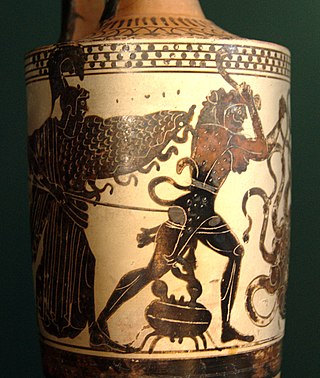
Cancer or, simply the Crab, is a giant crab in Greek mythology that inhabited the lagoon of Lerna. He is a secondary character in the myth of the twelve labors of Heracles, who attacks Heracles on Hera's orders, while Heracles is in the midst of fighting the Hydra of Lerna. Heracles kills the Crab, who is rewarded for his efforts by Hera turning him into the constellation of Cancer.
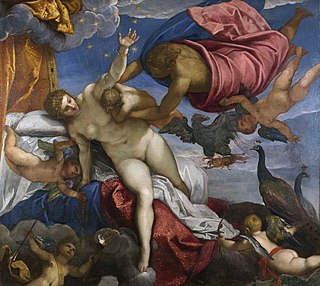
The myth of the milk of Hera is an ancient Greek myth and explanation of the origin of the Milky Way within the context of creation myths. The standard telling goes that the mythical hero Heracles, as an infant, breastfed from an unsuspecting Hera, the goddess of marriage and Zeus's wife, who threw him away, causing a little bit of her milk to splash and create the galaxy with all its stars.










